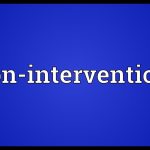Direct currency intervention is generally defined as foreign exchange transactions that are conducted by the monetary authority and aimed at influencing the exchange rate. Depending on the monetary base changes, currency intervention can be broadly divided into two types: sterilized and non-sterilized interventions.

Sterilized intervention
Sterilized intervention influences the exchange rate without changing the monetary base. There are two steps in it. First, the central bank buys (selling) foreign currency bonds with domestic currency. Then the monetary base is sterilized by selling (buying) equivalent domestic-currency-denominated bonds.
The net effect is the same as a swap of domestic bonds for foreign bonds without money supply changes. The purchase of foreign exchange is accompanied by a sale of an equivalent amount of domestic bonds, and vice versa.
The sterilized intervention has little or no effect on domestic interest rates. However, sterilized intervention can influence the exchange rate through the following two channels −
● The Portfolio Balance Channel − In the portfolio balance approach, agents balance their portfolios of domestic currency and bonds, and foreign currency and bonds. In case of any change, a new equilibrium is reached by changing the portfolios. Portfolio balancing influences the exchange rates.
● The Expectations or Signalling Channel − According to the signalling channel theory, agents see exchange rate intervention as a signal for a change of policy. The change of expectation affects the current level of the exchange rate.
Non-sterilized intervention
Non-sterilized intervention affects the monetary base. The exchange rate is affected due to purchase or sale of foreign money or bonds with domestic currency.
In general, non-sterilization influences the exchange rate by bringing changes in the monetary base stock, which, in turn, changes the monetary assets, interest rates, market expectations and finally, the exchange rate.


